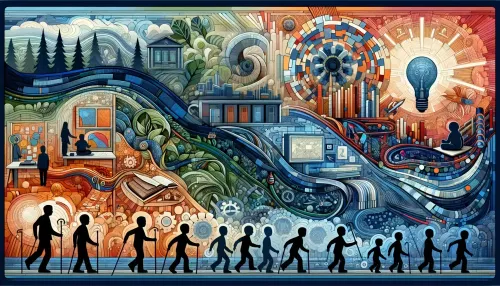Reimagining Autism Education: Innovations in Multisensory Learning Environments

Autism education has undergone a remarkable transformation in recent years, with a growing focus on creating inclusive and engaging learning environments. Central to this evolution is the adoption of multisensory learning approaches, which recognize the diverse sensory needs of autistic children and leverage these differences to enhance learning experiences.
Enhancing Learning through Sensory Engagement
Multisensory learning environments acknowledge that individuals process information in varied ways. For autistic children, this can mean different preferences for visual, auditory, tactile, or olfactory stimuli. By incorporating activities that stimulate these sensory modalities, educators can create more holistic and effective learning experiences.
In these environments, visual aids such as pictures, videos, and graphics are extensively used to convey information. Integrating colorful and engaging visual elements not only captures the attention of autistic children but also facilitates comprehension and retention of concepts. Similarly, auditory stimuli, including music, sound effects, and verbal cues, serve as powerful tools for reinforcing learning and promoting communication skills. Tactile experiences are equally crucial, as they provide opportunities for hands-on exploration and kinesthetic learning, enabling children to better understand abstract concepts by physically engaging with materials.
With the understanding that each child may have unique sensory preferences and sensitivities, a multisensory approach can be customized to suit individual needs, empowering autistic children to learn in ways that align with their strengths and preferences.
Understanding Sensory Preferences in Autistic Children
Technology plays a pivotal role in redefining autism education through personalized multisensory experiences. The integration of interactive digital platforms allows educators to tailor learning materials according to the specific sensory profiles of autistic students. Educational apps, virtual reality simulations, and interactive software can be customized to deliver content in various formats visual, auditory, tactile providing a truly personalized learning experience.
Furthermore, assistive technologies such as touch-responsive screens and sensory-based devices offer opportunities for direct engagement with educational materials. These technologies enable autistic children to interact with digital content in ways that resonate with their sensory preferences, fostering increased participation and comprehension.
Harnessing Technology for Personalized Multisensory Experiences
By leveraging technological advancements, educators can expand their toolkit for creating immersive and personalized learning experiences that cater to the diverse sensory needs of autistic children.
Utilizing Interactive Digital Platforms in Education
Educators are at the forefront of implementing innovative approaches to autism education. To support them in this endeavor, specialized teaching tools have emerged to enhance the delivery of multisensory instruction.
Augmented reality (AR) and virtual reality (VR) applications offer educators powerful tools for creating immersive and interactive learning experiences. These technologies enable the visualization of abstract concepts in three-dimensional space, allowing autistic children to engage with content in ways that transcend traditional classroom methods. By immersing students in virtual environments that align with their sensory preferences, educators can effectively convey complex subjects while promoting active learning and comprehension.
Related Article: Learning Adventure: Creative Educational Approaches to Cater to Autistic Childrens Diverse Learning Styles
Empowering Educators with Immersive Teaching Tools
Additionally, adaptive learning platforms equipped with customizable settings empower educators to tailor content presentation based on individual sensory profiles. These platforms provide insights into students' sensorimotor patterns, enabling instructors to adjust the delivery of material to best suit each child's unique needs.
Creating inclusive spaces for diverse learning styles within the context of autism education involves not only recognizing the diversity of sensory preferences among autistic children but also fostering an environment that celebrates these differences.
Implementing Augmented and Virtual Reality in Classrooms
Flexible classroom layouts that accommodate various sensory needs such as designated quiet areas for auditory sensitivity or tactile stations for hands-on exploration contribute to a supportive and inclusive learning environment. Furthermore, the incorporation of elements like adjustable lighting, calming colors, and sensory-friendly furniture enhances the overall comfort and accessibility of educational spaces.
Equally important is the collaboration between educators and occupational therapists to identify individual sensory needs and develop strategies tailored to address them effectively within the classroom setting. By integrating professional insights into creating personalized accommodations, educators can ensure that every autistic child has access to an environment optimized for their unique sensory requirements.
Creating Inclusive Spaces for Diverse Learning Styles
In conclusion, reimagining autism education through innovations in multisensory learning environments not only enhances the educational experience but also promotes inclusivity and empowers autistic children to thrive in an environment tailored to their diverse sensory preferences. By leveraging technology, empowering educators with immersive teaching tools, and creating inclusive spaces for diverse learning styles, we can champion a transformative approach to autism education that recognizes the value of individual differences and fosters meaningful engagement and growth.
Frequently Asked Questions
Multisensory learning environments in autism education are designed to cater to the diverse sensory needs of autistic children. They incorporate visual, auditory, tactile, and olfactory stimuli to enhance learning experiences. By engaging multiple senses, these environments help children process information more effectively and promote better comprehension and retention of concepts.
Technology enhances multisensory learning for autistic children by providing personalized educational experiences through interactive digital platforms. Tools like educational apps, virtual reality simulations, and assistive technologies allow educators to tailor content according to individual sensory profiles, fostering greater engagement and understanding while accommodating diverse learning styles.
Creating inclusive spaces in autism education is crucial because it recognizes and accommodates the diverse sensory preferences of autistic children. Inclusive environments, featuring flexible layouts and sensory-friendly elements, promote comfort and accessibility. This approach fosters meaningful engagement, allowing each child to thrive in a supportive setting tailored to their unique needs.
Check Out These Related Articles

Revolutionizing Autism Education: The Dawn of Personalized Learning Environments

Neurodiversity in Education: Redefining Teaching Approaches for Autistic Students

Inclusive Education: Tailoring Learning Pathways for Varied Autistic Profiles
